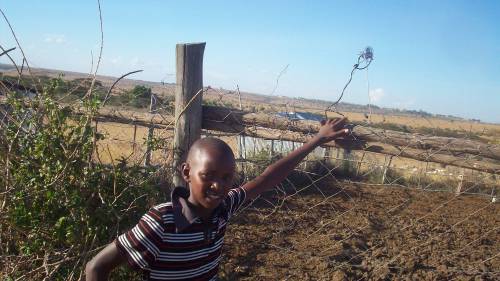Coexisting with wildlife has always been a problem for mankind. New technology has given us the opportunity to coexist with wildlife like never before. Here are just a few nifty things:
Critter Crossing
If you live in a wooded area like I do, you are very familiar with the sight of roadkill. It's an unfortunate result of the expansion of human development that cannot be prevented....or can it? In the Netherlands, wildlife crossing bridges have been made to allow animals to cross over roadways safely. Not only is it good for the animals, it's also good for people- in the US there are 200 fatalities annually due to collisions with deer. For educational purposes, the bridges can be fitted with cameras to collect data about the animals using them, providing important information about wildlife populations. In North America, only Alberta, Canada, has these structures, but hopefully we will see them more widespread in the very near future!
Shark Suits
The fear of sharks keeps many people out of the ocean. But sadly, most incidents with sharks are when they mistake a person for something else. These special wetsuits are meant to help mitigate that possibility. Some designs are blue and wavy to camouflage in the ocean, and some are striped to mimic lionfish- something sharks don't want to eat. However, these designs aren't guaranteed to help, and some scientists think it might have the opposite effect. Don't worry, if you're really paranoid you can just wear chain-mail underwater.
Shining the Light on Lions
This story is from 2013, but is by no means outdated. A 12-year-old boy from Kenya sought to stop lions from killing livestock in a non-lethal manner. He came up with a simple system of moving lights, and viola! the lions are deterred from livestock, and saved from the gun of an angry farmer. The moral of the story? Sometimes simple solutions are the best, and no matter what age you are, you can make a difference. Read more about it here.
Edible Cutlery
I've talked about the horrors of plastic before, and this invention specifically tackles the problem of plastic utensils, such as the ones used by fast-food joints once then thrown away. This company has made edible cutlery out of sorghum flour, which is incredibly efficient to manufacture, saving energy and reducing plastic waste. They even come in different flavors! Less plastic means a healthier planet for us and wildlife.
Thanks for reading everyone, and I hope you come back soon!
Monday, March 28, 2016
Monday, March 21, 2016
Creature Feature: The Mighty Manta Ray
In today's blog, I'll be talking about these gorgeous animals:
Manta rays are cartilaginous fish, just like sharks and sting rays. There are two main types: oceanic and reef mantas. The oceanic mantas are migratory animals, whereas the reef varieties tend to stay local. Some mantas can be 23 feet long and weigh over 4,0000 pounds! Despite their potentially massive size, they eat tiny zooplankton, arrow worms, copepods, and mysid shrimp. There is a lot of information we still need to discover about manta rays. For example, we don't even know their exact lifespan, although guesses are between 50 and 100 years old.
Their courtship rituals are very interesting: male mantas will follow a female in a train, copying her every move, until she determines which is most physically fit and persistent (see video below). Manta rays are ovoviviparous, meaning they reproduce with young in eggs that hatch inside the body of the mother. Although witnessed in captivity, there have been no wild manta births ever recorded.
Since March is Woman's History Month, let me take this opportunity to talk about a pioneering scientist. Leading the world in research on manta rays is Andrea Marshall. Known as "Queen of the Mantas", she is the first person in the world to complete a PhD on them, and has co-founded the Marine Megafauna Foundation. In the words of her website: "Aside from dramatically increasing the level of knowledge on manta rays themselves, Andrea’s discovery of a new giant species of manta ray in 2008 was one of the largest new species to have been described by any scientist in the last 50 years. She is currently working towards the description of a third Manta species. Using her extensive travels to uncover anthropogenic threats to manta rays and expose unsustainable fisheries for them, Andrea remains deeply committed to developing better management strategies for regional populations of these rays and their critical habitats." You go Andrea!
Gill rakers, thin filaments in a manta ray's body, are used to filter food out of the water. But in recent years, they have been more harmful than helpful, since human's have decided they are valuable. Very similar to tiger bones or rhino horns, gill rakers can be used in traditional medicine, primarily in Southern China. They are also used as a substitute for shark cartilage in certain "medicines" (so we can only save one cartilaginous fish at a time I guess?). You can learn more from SharkSaver's website here. Some states and countries have banned the sale and trade of manta parts, but conservation efforts are nowhere near finished. A few blogs ago, I reviewed the show "Racing Extinction", and one of their feature stories was about a town in Indonesia. This village was responsible for the deaths of thousands of mantas, but after a decision by CITES, Indonesia became the world's largest manta ray sanctuary in January 2014. And what about the villagers you may ask? With help from organizations like WildAid, their town is becoming a thriving hub for ecotourism, and a shining example of how conservation efforts really can make a difference.
There are lots of really awesome organizations out there that are promoting manta conservation. Here are just a few links you should check out:
Manta Trust
Project Aware
Manta Ray of Hope
You can also visit one of my favorite blogs, Voice for the Voiceless, for more information on the conservation of rays, sharks and whales.
Thanks for reading everyone!
Manta rays are cartilaginous fish, just like sharks and sting rays. There are two main types: oceanic and reef mantas. The oceanic mantas are migratory animals, whereas the reef varieties tend to stay local. Some mantas can be 23 feet long and weigh over 4,0000 pounds! Despite their potentially massive size, they eat tiny zooplankton, arrow worms, copepods, and mysid shrimp. There is a lot of information we still need to discover about manta rays. For example, we don't even know their exact lifespan, although guesses are between 50 and 100 years old.
 |
| A life-size model of an oceanic manta caught off of New Jersey in 1933. |
 |
| It seems like I post a lot of pictures like this: a huge collection of body parts from a species of animal, taken by humans for their own selfish (and unnecessary) purpose. |
There are lots of really awesome organizations out there that are promoting manta conservation. Here are just a few links you should check out:
Manta Trust
Project Aware
Manta Ray of Hope
You can also visit one of my favorite blogs, Voice for the Voiceless, for more information on the conservation of rays, sharks and whales.
Thanks for reading everyone!
Subscribe to:
Posts (Atom)




